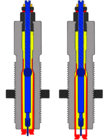I keep hearing this and as someone who's worked at forming (which involved various methods of squeezing) various aircraft sheet metals, I find it's really not quite correct. When the collet squeezes down there's only pressure on the outside of the neck until the inside of the neck makes contact with the mandrel. Then from there the pressure builds quickly on both sides until it's pretty much equal (equal on both sides). Equal pressure on both sides will not move anything from one side to the other.
Often, when we talk about "irregularities" its about the difference in the axis alignments of the inside and outside diameter. We can often see this difference when neck turning where part of the neck isn't touched while the other side is shaved. This kind of "irregularity" is not "moved to the outside". While the inside diameter axis might be straightened and/or aligned with the case body axis, the neck's inside and outside diameter axes are still not moved into alignment. Only neck turning will get those two axes aligned.
Irregularities, say something like a pimple, or even a narrow band (like a donut) can be squeezed INTO the neck material as the irregularity, with it's small surface area, can not withstand the pressure exerted on it as the opposite side's full surface can. If we use too much lube when sizing, we can see a dimple produced in the brass because liquid is so more difficult to compress than the brass and so the brass is compressed where the liquid has puddled. When that dimple is formed, has that brass moved to the inside? Not much and not at all if against something like a mandrel. . . as it's squeezed into the case or shoulder material around it. Where does it go? Since it has to go somewhere, its manifested in where the brass is squeezed out making the case longer. The same goes for squeezing the neck with a collet die.
Now if you want to move the irregularity to the outside, like a donut, just running a mandrel through the inside of the neck to expand the inside diameter and it will, in effect, move the irregular thickness to the outside. The same effect happens when running a bushing over the outside of the neck, which gives the opposite effect of running an mandrel through the inside.
One can verify any of this by simply taking detailed measurements before and after doing the process.

Well, that's my understanding of it all after measuring, measuring and measuring. I could be wrong, but it would take a lot to change it. And being old and stubborn, maybe it'd be impossible.















